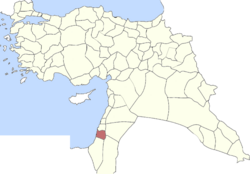Jabal Nablus
| Sanjak of Nablus | |||||
| Sanjak of the Ottoman Empire | |||||
|
|||||
|
Coat of arms |
|||||
| Sanjak of Nablus, 1914 | |||||
| Capital | Nablus | ||||
| History | |||||
| • | Ottoman capture of Mamluk Syria | 1516 | |||
| • | Sykes–Picot Agreement | 16 May 1916 | |||
| Today part of |
|
||||
Coat of arms
The District of Nablus also known as the Sanjak of Nablus is an administrative area that existed throughout Ottoman rule of Ottoman Syria and to a lesser extent during British rule.
In the 1596- daftar, the Sanjak of Nablus contained the following subdivisions and villages/town:
In the 19th century, it consisted of nearly 113 towns and villages, in addition to the city of Nablus. From the 17th to the early 20th century it maintained its autonomy of Ottoman rule, mostly due to the mountainous terrain and Nablus's strategic location between Mount Ebal and Mount Gerizim. The rulers of the district composed of several Arab families, some originating from northern Syrian cities, some from Balqa and others were indigenous to Nablus. The primary noble families were the Tuqan, Jarrar, Abd al-Hadi, Jayyusi, Nimr, Rayyan, Qasim, At'ut, al-Hajj Muhammad, Ghazi and Jaradat. Sanjaq Nablus comprised five nahiyas ("subsdistricts"): Jamma'in East (21 villages), Jamma'in West (25 villages), Mashariq Nablus (20 villages), Wadi al-Sha'ir (23 villages) and Sha'rawiyya (24 villages). Jamma'in East was headed by the Qasim clan, Jamma'in West by the Rayyan, Wadi al-Sha'ir by the Sayf and al-Ahfa clans, Mashariq Nablus by the Hajj Muhammad clan and Sha'rawiyya by the Abd al-Hadi clan. The Tuqan, Nimr and Abd al-Hadi families controlled Nablus.
...
Wikipedia


